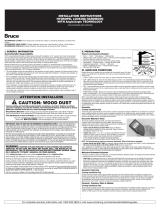Page is loading ...

Board Replacement Instructions
Simple step by step instructions on how to replace damaged boards.
Step 1:
Use a circular saw to make several cuts on the board that is to be replaced. The correct
depth of the saw blade should be double-checked before cutting. Ideally, a 24-tooth saw
blade is used. Note that the undamaged floor is protected by a piece of cardboard. To
further protect the floor, the bottom of the circular saw could be covered with tape.
The saw is used to make two long cuts to the outer edge of each board. (Cut in 3/8 inch
from each side of the board.
Step 2:
Make several diagonal cuts between the two parallel cuts in each board, being careful
not to cut into surrounding boards.
Step 3:
Pick out the loose board pieces, and then use the chisel to carefully separate the
remaining pieces from the surrounding boards. Be sure to cut away the Elastilon below

the remaining boards so that it is completely removed from the area of the replaced
board.
Step 4:
For your replacement boards, choose boards of the same specie and similar grain
pattern as the ones you removed. Examine the boards for straightness and correct
milling. Measure them precisely. The tongue end of the board will be removed.
Use a chop saw to make the cut, tipping the board up on edge to cut it. That position
prevents the chop saw blade from flaring out and allows for a truer cut than if the board
is cut laying flat.
Step 5:
In order for the board to go in, the bottom of the groove needs to be removed. The razor
knife is used to score along the bottom of the groove, which is then knocked off.
Placing another board along the edge of the groove and whacking it with a hammer can
help the process. As always, be careful not to damage the floor below in the process.
Step 6:
With the bottom of the groove knocked off, use a planer to finish the job.

Step 7:
Use a chop saw to knock off the bottom on the board's grooved end.
Then, on the side where you made your original cut, make a cut at a 45-degree angle (as
shown above), which will allow the board to fit in more readily. Be careful not to angle
the cut too close to the top of the wear layer, or it will leave a gap when the board is
sanded down to the level of the rest of the floor.
At this point cover the bottom of the replacement board with Elastilon being sure to
only cover the bottom portion. Trim the Elastilon so that it does not interfere with the
t&g or Elastilon already on the existing floor.
Step 8:
Each board has been dry-fit (not knocking it in quite all the way) to make sure it will go
in. Once the glue is applied, especially if you use exopy, there won't be much time to
mess around with further adjustments. Where a long board has been removed, it can be
easier to put in two short boards rather than one long one, as shown here. (Remember
to check for joint spacing.) Also, if many boards are being removed, remove and repair
only one at a time. If all are removed at once, the pressure of the floor may shrink the
gap too much to do the repair.
Step 9:

Use two-part epoxy if you are planning to re-sand the floor otherwise regular PVA
carpenters glue can be used on top of the tongues and at the end matches. Glue all
sides of the replacement board in place. Epoxy has various set-up times so be careful
to allow for this. Again regular carpenters wood glue can be used, but requires a wait of
24 to 48 hours before you can sand the floor.
Step 10:
The glue is also applied to the top of the end match. Note that the glue is being used to
attach the boards to each other, not the subfloor. This will allow the boards to move
with the rest of the floor. Never glue the bottom of the boards! Never attempt to glue the
replacement to the subfloor below! The floor must remain free floating at all times.
Clean all glue residues and add weight to the top of the boards until the glue has as a
chance to set.
October 5, 2011
/








